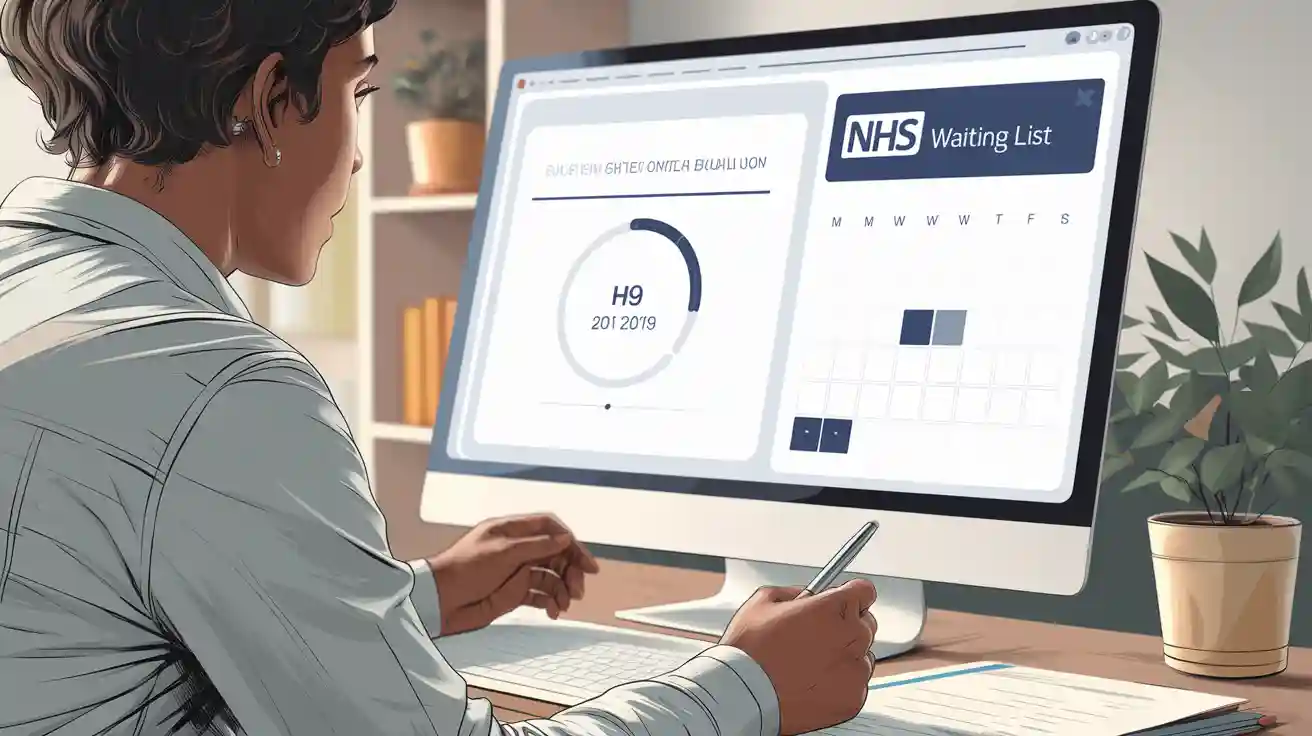How do I find out where I am on NHS waiting list England

If you ask, "how do I find out where I am on NHS waiting list England," there are simple ways to find out. You can call your doctor, contact the hospital, or check online using the NHS App. Keep your NHS number and referral details ready to save time. In England, these tools help you check your waiting list and stay updated about your treatment.
Key Takeaways
Ask your GP or specialist for updates about your NHS waiting list. They can check your records and give correct details.
Use online tools like the NHS App or My Planned Care to see your waiting list status. These tools are easy to use and save time.
If you have problems or delays, contact the Patient Advice and Liaison Service (PALS) for help. They can sort out issues and give advice.
Contacting Your Healthcare Provider
Why your GP or specialist is the first person to ask
Your GP or specialist helps manage your care in the NHS. They connect you to hospital treatments and specialist services. For non-urgent care, your GP gives you a referral. This referral puts you on the NHS waiting list. So, they are the best person to ask about waiting times or treatment updates.
GPs are trained to help with referrals and patient care. They can check your records and tell you your waiting list position. If you are already seeing a specialist, they can also help. Specialists can explain how long you might wait and what happens next.
What to have ready before contacting them
Before calling your GP or specialist, get your details organised. Having the right information makes it easier for them to help you. Here’s what you need:
Your NHS number: This helps them find your records quickly.
Referral details: Include when you were referred and the specialist’s name.
Personal information: Give your full name, birth date, and address.
Specific questions: Write down what you want to ask about your waiting list or treatment.
Being prepared saves time and helps your GP or specialist answer your questions better.
Questions to ask about your NHS waiting list
When talking to your GP or specialist, ask clear questions. This helps you get the answers you need. Here are some examples:
"Where am I on the NHS waiting list?"
"How long will I wait for my treatment?"
"Has my referral status changed recently?"
"Can I do anything to speed up the process?"
"Who else can I contact for more information?"
These questions help you understand your situation better. If your GP or specialist doesn’t know, they might send you to the hospital or another service for help.
Contacting the Hospital
How to find your hospital and reach out
To check your NHS waiting list, contact the hospital directly. First, find out which hospital is handling your care. This is usually in your referral letter or appointment details. If you’re unsure, ask your GP for help.
Once you know the hospital, visit its website. Look for the "Contact Us" section to find phone numbers or email addresses. Call the main switchboard and ask for the patient enquiries team. Keep your NHS number and referral details ready. These help staff find your records faster.
Questions to ask about your waiting list
When talking to hospital staff, ask clear questions. For example:
"Where am I on the waiting list?"
"How long will I wait for treatment?"
"Has my referral status changed?"
"What should I do if my condition gets worse?"
These questions help you understand your situation better. Hospitals track waiting times and patient feedback. Knowing this can help you plan what to do next.
Tips for talking to hospital staff
Good communication makes things easier. Here are some tips:
Be polite and patient when asking questions.
Tell staff if your condition has changed.
Ask what you need to bring to your appointment.
Request written information for future reference.
Hospitals often send updates or share helpful advice to reduce stress. If you feel overwhelmed, ask for only the most important details. This can make things simpler and less worrying.
Using Online Tools to Check NHS Waiting Times
Online tools help you check your NHS waiting list spot. Platforms like My Planned Care and the NHS App give quick updates. These tools save time and reduce calls or visits to your GP or hospital.
How to use the My Planned Care platform
My Planned Care shows waiting times for hospital treatments in England. It is easy to use and does not need a login. Follow these steps to begin:
Open the My Planned Care website on your internet browser.
Choose the hospital or NHS trust handling your care. Look for this in your referral letter.
Check the data on waiting times for different treatments.
This platform gives general waiting time estimates, not your exact spot. But it helps you see how long others wait for similar treatments.
New features, like virtual clinics, have shortened waiting times for appointments. These clinics also reduce missed appointments, keeping waiting lists from growing too much.
Checking your status through the NHS App
The NHS App offers a personalised way to track your waiting list. It links to your medical records for detailed updates. Here’s how to use it:
Download the NHS App from your device’s app store.
Sign up with your email and NHS number.
Log in and go to the referrals or appointments section.
Look for updates on your waiting list or appointments.
The app also lets you manage prescriptions, book GP visits, and view health records. However, its accuracy for real-time waiting lists can vary. For example, a recent check showed only 43% of records were correct. Some records had missing or wrong waiting times, which might affect your experience.
Finding | Description |
|---|---|
Record Accuracy | Only 43% of records were correct for checked patients. |
Missing Records | 31% of cases lacked documents to confirm waiting times. |
Under-recording | 145 cases had waiting times underestimated by three weeks. |
Over-recording | 22 cases had waiting times overestimated by 75 days. |
Despite these issues, the app is still useful for staying updated about your care.
Benefits of using online tools for tracking your waiting list position
Online tools like My Planned Care and the NHS App have many benefits:
Convenience: Check information anytime without calling your GP or hospital.
Transparency: These tools show waiting times and help you plan ahead.
Time-saving: NHS trusts use technology to speed up waiting list updates.
Patients have mixed feelings about the NHS App. Many like features like prescription ordering and the COVID Pass. But some face problems with access or limited features.
User Experience Aspect | Findings |
|---|---|
NHS App Usage | Increased after lockdown, especially with the NHS COVID Pass. |
Unequal Access | Different groups use the app in varied ways. |
Research Needs | More studies needed on inequalities and their effects. |
Using these tools helps you stay informed and manage your healthcare better. If you face problems, contact your GP or hospital for help.
What to Do If You Face Issues
Getting Help from the Patient Advice and Liaison Service (PALS)
If you have problems with your NHS waiting list, PALS can assist. PALS helps solve issues and gives advice about your care. Contact them if there are delays, no updates, or unclear information.
To find PALS, check your hospital’s website for contact details. You can also ask your GP or hospital staff for help. When reaching out, explain your problem clearly. Share your NHS number, referral details, and past communication with the hospital. This helps PALS handle your concerns better.
Steps to Follow if You Face Delays or No Updates
Delays or missing updates can be upsetting. Here’s what you can do:
Talk to your GP or specialist: They can check your referral and give updates.
Contact the hospital: Ask the patient enquiries team about your waiting list spot.
Use online tools: The NHS App or My Planned Care can show waiting times.
Hospitals now focus on urgent cases and better scheduling to reduce delays. New technologies like telemedicine also help speed up processes. These changes aim to shorten waiting times for treatments.
How to Speak Up for Your Care and Get More Support
Speaking up ensures your concerns are noticed. Keep records of appointments, referrals, and messages. If your issues aren’t resolved, contact PALS or your hospital’s complaints team.
Better data sharing in NHS England hospitals has improved access to services. This progress is tracked by the Clinical Digital Maturity Index, which measures digital improvements. By staying informed and persistent, you can manage the system better and reduce waiting times.
Tip: Always stay calm and polite when raising concerns. Clear communication often leads to faster solutions.
To check your spot on the NHS waiting list in England, follow these steps. First, ask your GP or specialist for updates. Next, contact the hospital handling your care. Finally, use online tools like the NHS App or My Planned Care to see waiting times.
If you have problems, help is available. The Patient Advice and Liaison Service (PALS) can assist with issues. Political parties are also working on plans to improve waiting lists. For example:
Labour wants to invest in hospitals and new ideas to meet NHS standards in five years.
The Conservatives plan to build 40 hospitals and 50 diagnostic centres by 2030.
Stay organised and ask clear questions to get answers. This helps you stay informed and manage your healthcare better.
FAQ
How long will I wait for my treatment?
The waiting time depends on your condition and hospital. You can check estimated times using the NHS App or My Planned Care platform.
Can I change my hospital to reduce waiting times?
Yes, you can request a transfer to another hospital. Speak to your GP or specialist to explore this option and understand the process.
What should I do if my condition worsens while waiting?
Contact your GP or hospital immediately. They may reassess your case and prioritise your treatment based on the urgency of your condition.
See Also
A Beginner's Guide to Navigating NHS Waiting Lists
Decoding NHS Waiting Times: How They Are Calculated
An Overview of NHS Physiotherapy Waiting Lists Explained
Essential Information About NHS Waiting Times You Should Know

